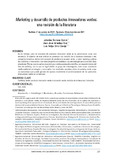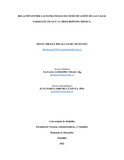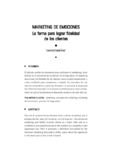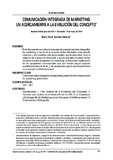Marketing and Development of Green Innovative Products: a Literature Review
Marketing y desarrollo de productos innovadores verdes: una revisión de la literatura;
Marketing e desenvolvimento de produtos innovadores verdes: uma revisão da literatura
| dc.contributor.author | Serrano-García, Jakeline | |
| dc.contributor.author | Arbeláez-Toro, Juan José | |
| dc.contributor.author | Ortiz-Clavijo, Luis Felipe | |
| dc.coverage.spatial | Lat: 06 15 00 N degrees minutes Lat: 6.2500 decimal degreesLong: 075 36 00 W degrees minutes Long: -75.6000 decimal degrees | |
| dc.date.accessioned | 2024-01-23T16:05:59Z | |
| dc.date.available | 2024-01-23T16:05:59Z | |
| dc.date.created | 2022-07-27 | |
| dc.identifier.issn | 0120-6346 | |
| dc.identifier.uri | http://hdl.handle.net/11407/8252 | |
| dc.description | In recent years, the concept of green innovative product has become a trend. The main objective of this article is to present a literature review in three axes within the concept of green innovative product: marketing, supply chain and innovation. With this purpose, the study established a methodology for reviewing under the Prisma standard, which found a fertile scientific production, specially within the marketing realm, and which allowed the reduction of a group of subcategories such as environmental consciousness, strategies, and consumer. The results allow the allocation of green marketing as a mechanism that can consciously generate the positioning of innovative green products in the market. | eng |
| dc.description | En los últimos años el concepto de producto innovador verde se ha posicionado como una tendencia. El objetivo de este artículo es presentar una revisión de la literatura orientada a tres categorías temáticas dentro del concepto de producto innovador verde, a saber: marketing, cadena de suministro e innovación. Con este propósito se establece una metodología para la revisión bajo el estándar Prisma, con la cual se encontró una nutrida producción científica, en especial dentro del área de marketing, con lo que se logró definir un grupo de subcategorías, tales como conciencia medioambiental, estrategias y consumidor. Los resultados permiten ubicar el marketing verde como un mecanismo que puede generar de manera consistente el posicionamiento de los productos innovadores verdes en el mercado. | spa |
| dc.description | Nos últimos anos o conceito de produto inovador tem se posicionado como uma tendência. O objetivo deste artigo é apresentar uma revisão de literatura orientada a três categorias temática dentro do conceito de produto inovador verde, a saber: marketing, cadeia de abastecimento e inovação. Com este propósito é definida uma metodologia para a revisão sob o padrão Prisma, com a qual se encontrou uma nutrida produção científica, em especial dentro da área do marketing, o que se conseguiu definir um grupo de subcategorias, tais como sensibilização ambiental, estratégias e consumidor. Os resultados permitem colocar o marketing verde como um mecanismo que pode gerar de modo consciente o posicionamento dos produtos inovadores verde no mercado. | por |
| dc.format | ||
| dc.format.extent | p. 201-216 | |
| dc.format.medium | Electrónico | |
| dc.format.mimetype | application/pdf | |
| dc.language.iso | spa | |
| dc.publisher | Universidad de Medellín | |
| dc.relation.ispartofseries | Semestre Económico; Vol. 24 No. 57 (2021) | |
| dc.relation.haspart | Semestre Económico; Vol. 24 Núm. 57 julio-diciembre 2021 | |
| dc.relation.uri | https://revistas.udem.edu.co/index.php/economico/article/view/3972 | |
| dc.rights.uri | http://creativecommons.org/licenses/by-nc-nd/4.0 | * |
| dc.source | Semestre Económico; Vol. 24 No. 57 (2021): (julio-diciembre); 201-216 | |
| dc.subject | Green marketing | eng |
| dc.subject | Green innovative products | eng |
| dc.subject | Green innovation | eng |
| dc.subject | Literature review | eng |
| dc.subject | Colombia | eng |
| dc.subject | Marketing verde | spa |
| dc.subject | Producto innovador verde | spa |
| dc.subject | Innovación verde | spa |
| dc.subject | Revisión de la literatura | spa |
| dc.subject | Colombia | spa |
| dc.subject | Marketing verde | por |
| dc.subject | Produto inovador verde | por |
| dc.subject | Inovação verde | por |
| dc.subject | Revisão de literatura | por |
| dc.subject | Colômbia | por |
| dc.title | Marketing and Development of Green Innovative Products: a Literature Review | eng |
| dc.title | Marketing y desarrollo de productos innovadores verdes: una revisión de la literatura | spa |
| dc.title | Marketing e desenvolvimento de produtos innovadores verdes: uma revisão da literatura | por |
| dc.type | article | |
| dc.identifier.doi | https://doi.org/10.22395/seec.v24n57a10 | |
| dc.relation.citationvolume | 24 | |
| dc.relation.citationissue | 57 | |
| dc.relation.citationstartpage | 201 | |
| dc.relation.citationendpage | 216 | |
| dc.audience | Comunidad Universidad de Medellín | |
| dc.publisher.faculty | Facultad de Ciencias Económicas y Administrativas | |
| dc.publisher.place | Medellín | |
| dc.relation.references | Aagerup, U., Frank, A.-S. y Hultqvist, E. (2019). The persuasive effects of emotional green packaging claims. British Food Journal, 121(12), 3233-3246. https://doi.org/10.1108/BFJ-08-2019-0652 | |
| dc.relation.references | Abu Seman, N. A., Govindan, K., Mardani, A., Zakuan, N., Mat Saman, M. Z., Hooker, R. E. y Ozkul, S. (2019). The mediating effect of green innovation on the relationship between green supply chain management and environmental performance. Journal of Cleaner Production, 229, 115-127. https://doi.org/10.1016/j.jclepro.2019.03.211 | |
| dc.relation.references | Amoako, G. K., Dzogbenuku, R. K. y Abubakari, A. (2020). Do green knowledge and attitude influence the youth’s green purchasing? Theory of planned behavior. International Journal of Productivity and Performance Management, 69(8), 1609-1626. https://doi.org/10.1108/IJPPM-12-2019-0595 | |
| dc.relation.references | Belz, F-M. y Peattie, K. (2014). Sustainability Marketing: A Global Perspective. John Wiley & Sons. | |
| dc.relation.references | Ben Moussa, F. Z., Rasovska, I., Dubois, S., De Guio, R. y Benmoussa, R. (2017). Reviewing the use of the theory of inventive problem solving (TRIZ) in green supply chain problems. Journal of Cleaner Production, 142, 2677-2692. https://doi.org/10.1016/j.jclepro.2016.11.008 | |
| dc.relation.references | Burch, M., Lohmann, S., Beck, F., Rodriguez, N., Silvestro, L., Di y Weiskopf, D. (2014). RadCloud: Visualizing multiple texts with merged word clouds. Proceedings of the International Conference on Information Visualisation, 108-113. https://doi.org/10.1109/IV.2014.72 | |
| dc.relation.references | Dangelico, R. M. (2017). What Drives Green Product Development and How do Different Antecedents Affect Market Performance? A Survey of Italian Companies with Eco-Labels. Business Strategy and the Environment, 26(8), 1144-1161. https://doi.org/10.1002/bse.1975 | |
| dc.relation.references | Dangelico, R. M. y Vocalelli, D. (2017). “Green Marketing”: An analysis of definitions, strategy steps, and tools through a systematic review of the literature. Journal of Cleaner Production, 165, 1263-1279. https://doi.org/10.1016/j.jclepro.2017.07.184 | |
| dc.relation.references | Del Carpio, P. M. (2017). Extracting word clouds in Git repositories | Extracción de Nubes de Palabras en Repositorios Git. Iberian Conference on Information Systems and Technologies, CISTIk, 1-6. https://doi.org/10.23919/CISTI.2017.7975911 | |
| dc.relation.references | Díaz, C., González, Á. y Sáez, F. J. (2015). Eco-innovation: Insights from a literature review. Innovation: Management, Policy and Practice, 17(1), 6-23. https://doi.org/10.1080/14479338.2015.1011060 | |
| dc.relation.references | Garg, A. (2015). Green Marketing for Sustainable Development: An Industry Perspective. Sustainable Development, 23(5), 301-316. https://doi.org/10.1002/sd.1592 | |
| dc.relation.references | Gupta, H. y Barua, M. K. (2017). Supplier selection among SMEs on the basis of their green innovation ability using BWM and fuzzy TOPSIS. Journal of Cleaner Production, 152, 242-258. https://doi.org/10.1016/j.jclepro.2017.03.125 | |
| dc.relation.references | Harrison, R., Meyer, L., Rawstorne, P., Razee, H., Chitkara, U., Mears, S., y Balasooriya, C. (2020). Evaluating and enhancing quality in higher education teaching practice: a meta-review. Studies in Higher Education, 1-17. https://doi.org/10.1080/03075079.2020.1730315 | |
| dc.relation.references | Hernández, R., Fernández, C. y Baptista, P. (2010). Metodología de la investigación. McGraw-Hill. | |
| dc.relation.references | Hong, Z. y Guo, X. (2019). Green product supply chain contracts considering environmental responsibilities. Omega (United Kingdom), 83, 155-166. https://doi.org/10.1016/j.omega.2018.02.010 | |
| dc.relation.references | Hong, Z., Li, M., Han, X. y He, X. (2020). Innovative green product diffusion through word of mouth. Transportation Research Part E: Logistics and Transportation Review, 134, 1-25. https://doi.org/10.1016/j.tre.2019.101833 | |
| dc.relation.references | Hu, M., Wongsuphasawat, K. y Stasko, J. (2017). Visualizing Social Media Content with SentenTree. IEEE Transactions on Visualization and Computer Graphics, 23(1), 621-630. https://doi.org/10.1109/TVCG.2016.2598590 | |
| dc.relation.references | Hua, Y., Bao, L. y Wu, X. (2021). The product-selling strategy under direct and indirect value identification. Journal of Cleaner Production, 279, 1-13. https://doi.org/10.1016/j.jclepro.2020.123591 | |
| dc.relation.references | Jasti, N. V. K., Sharma, A. y Karinka, S. (2015). Development of a framework for green product development. Benchmarking, 22(3), 426-445. https://doi.org/10.1108/BIJ-06-2014-0060 | |
| dc.relation.references | Jayaraman, V., Singh, R. y Anandnarayan, A. (2012). Impact of sustainable manufacturing practices on consumer perception and revenue growth: An emerging economy perspective. International Journal of Production Research, 50(5), 1395-1410. https://doi.org/10.1080/00207543.2011.571939 | |
| dc.relation.references | Kumar, P. (2016). State of green marketing research over 25 years (1990-2014): Literature survey and classification. Marketing Intelligence and Planning, 34(1), 137-158. https://doi.org/10.1108/MIP-03-2015-0061 | |
| dc.relation.references | Lee, C. K. M. y Lam, J. S. L. (2012). Managing reverse logistics to enhance sustainability of industrial marketing. Industrial Marketing Management, 41(4), 589-598. https://doi.org/10.1016/jindmarman.2012.04.006 | |
| dc.relation.references | Linder, M. (2012). A problem-solving perspective on strategies for appropriating environmental value - Some implications from considering institutional solutions to social dilemmas. International Journal of Innovation and Sustainable Development, 6(2), 164-183. https://doi.org/10.1504/IJISD.2012.046946 | |
| dc.relation.references | Linder, M. (2016). Determinants of economic performance of environmental technology-based offers: A cross sectional study of small Swedish firms. International Journal of Innovation and Sustainable Development, 10(3), 237-259. https://doi.org/10.1504/IJISD.2016.077502 | |
| dc.relation.references | Martínez-Ros, E. y Kunapatarawong, R. (2019). Green innovation and knowledge: The role of size. Business Strategy and the Environment, 28(6), 1045-1059. https://doi.org/10.1002/bse.2300 | |
| dc.relation.references | Martinez, J., Ziadi, T., Bissyandé, T. F., Klein, J. y Traon, Y. Le. (2016). Name suggestions during feature identification: The VariClouds approach. ACM International Conference Proceeding Series, 16-23-September-2016, 119-123. https://doi.org/10.1145/2934466.2934480 | |
| dc.relation.references | Melander, L. (2017). Achieving Sustainable Development by Collaborating in Green Product Innovation. Business Strategy and the Environment, 26(8), 1095-1109. https://doi.org/10.1002/bse.1970 | |
| dc.relation.references | Melander, L. (2018). Customer and Supplier Collaboration in Green Product Innovation: External and Internal Capabilities. Business Strategy and the Environment, 27(6), 677-693. https://doi.org/10.1002/bse.2024 | |
| dc.relation.references | Monteiro, T. A., Giuliani, A. C., Cavazos-Arroyo, J. y Kassouf, N. (2015). Mezcla del marketingverde: una perspectiva teórica. Cuadernos del CIMBAGE, (17), 103-126. http://www.redalyc.org/articulo.oa?id=46243484005 | |
| dc.relation.references | Mukonza, C. y Swarts, I. (2020). The influence of green marketing strategies on business performance and corporate image in the retail sector. Business Strategy and the Environment, 29(3),838-845.https://doi.org/10.1002/bse.2401 | |
| dc.relation.references | Ploenhad, J., Khasasin, R., Khasasin, K. y Prachuabmoh, A. (2020). Green supply chain management as antecedent of green satisfaction: Examining sequential mediation of green marketing and green corporate image. International Journal of Supply Chain Management, 9(2), 419-426.https://ojs.excelingtech.co.uk/index.php/IJSCM/article/view/4618 | |
| dc.relation.references | Rustam, A., Wang, Y. y Zameer, H. (2020). Environmental awareness, firm sustainability exposure and green consumption behaviors. Journal of Cleaner Production, 268, 1-28. https://doi.org/10.1016/j.jclepro.2020.122016 | |
| dc.relation.references | Singh, M. P., Chakraborty, A. y Roy, M. (2016). The link among innovation drivers, green innovation and business performance: Empirical evidence from a developing economy. World Review of Science, Technology and Sustainable Development, 12(4), 316-334. https://doi.org/10.1504/WRSTSD.2016.082191 | |
| dc.relation.references | Smith, V., Devane, D., Begley, C. M. y Clarke, M. (2011). Methodology in conducting a systematic review of systematic reviews of healthcare interventions. BMC Medical Research Methodology, 11(1), 15. https://doi.org/10.1186/1471-2288-11-15 | |
| dc.relation.references | Soewarno, N., Tjahjadi, B., y Fithrianti, F. (2019). Green innovation strategy and green innovation: The roles of green organizational identity and environmental organizational legitimacy. Management Decision, 57(11), 3061-3078. https://doi.org/10.1108/MD-05-2018-0563 | |
| dc.relation.references | Su, D., Duong, T. H., Dinh, M. y Nguyen-Phuoc, D. Q. (2020). Behavior towards shopping at retailers practicing sustainable grocery packaging: The influences of intra-personal and retailer-based contextual factors. Journal of Cleaner Production, 279(6), 1-12. http://dx.doi.org/10.1016/j.jclepro.2020.123683 | |
| dc.relation.references | Syaekhoni, M. A., Alfian, G. y Kwon, Y. S. (2017). Customer purchasing behavior analysis as alternatives for supporting in-store green marketing decision-making. Sustainability (Switzerland), 9(11), 1-22. https://doi.org/10.3390/su9112008 | |
| dc.relation.references | Terzi, A. (2020). Crafting an effective narrative on the green transition. Energy Policy, 147, 1-9. https://doi.org/10.1016/j.enpol.2020.111883 | |
| dc.relation.references | Tomasin, L., Pereira, G. M., Borchardt, M. y Sellitto, M. A. (2013). How can the sales of green products in the Brazilian supply chain be increased? Journal of Cleaner Production, 47, 274-282.https://doi.org/10.1016/j.jclepro.2013.01.028 | |
| dc.relation.references | Torres, M. (2014). Cadenas de suministro verdes, una respuesta al desempeño ambiental. Inventio, la génesis de la cultura universitaria en Morelos, 20, 43-48. | |
| dc.relation.references | Tseng, S-C. y Hung, S-W. (2013). A framework identifying the gaps between customers’ expectations and their perceptions in green products. Journal of Cleaner Production, 59, 174-184. https://doi.org/10.1016/j.jclepro.2013.06.050 | |
| dc.relation.references | Van Eck, N. J. y Waltman, L. (2013). VOSviewer manual. Manual for VOSviewer version 1 .6.15. Univeristeit Leiden. | |
| dc.relation.references | Wang, J., Wan, Q. y Yu, M. (2020). Green supply chain network design considering chain-to-chain competition on price and carbon emission. Computers and Industrial Engineering, 145, 1-11.https://doi.org/10.1016/j.cie.2020.106503 | |
| dc.relation.references | Wu, W., Yu, K., Ma, S., Chu, C.-C., Li, S., Ma, C. y Tsai, S.-B. (2018). An empirical study on optimal strategies of industry-university-Institute green innovation with subsidy. Sustainability (Switzerland), 10(5), 1-17. https://doi.org/10.3390/su10051667 | |
| dc.relation.references | Zhang, Q., Zhang, J. y Tang, W. (2017). Coordinating a supply chain with green innovation in a dynamic setting. 4OR, 15(2), 133-162. https://doi.org/10.1007/s10288-016-0327-x | |
| dc.relation.references | Zhu, Q. y Sarkis, J. (2016). Green marketing and consumerism as social change in China: Analyzing the literature. International Journal of Production Economics, 181, 289-302. https://doi.org/10.1016/j.ijpe.2016.06.006 | |
| dc.relation.references | Zhou, W., Su, D., Yang, J., Tao, D. y Sohn, D. (2021). When do strategic orientations matter to innovation performance of green-tech ventures? The moderating effects of network positions. Journal of Cleaner Production, 279, 1-9. https://doi.org/10.1016/j.jclepro.2020.123743 | |
| dc.rights.creativecommons | Attribution-NonCommercial-NoDerivatives 4.0 International | * |
| dc.identifier.eissn | 2248-4345 | |
| dc.type.coar | http://purl.org/coar/resource_type/c_6501 | |
| dc.type.version | info:eu-repo/semantics/publishedVersion | |
| dc.type.local | Artículo científico | |
| dc.type.driver | info:eu-repo/semantics/article | |
| dc.identifier.reponame | reponame:Repositorio Institucional Universidad de Medellín | |
| dc.identifier.repourl | repourl:https://repository.udem.edu.co/ | |
| dc.identifier.instname | instname:Universidad de Medellín |





